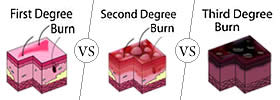

#First second and third degree burns skin
Second-degree burns are more serious and penetrate through the epidermis to involve the next layer of skin known as the dermis. Shop for lidocaine and aloe productsįirst-degree burns involve only the epidermis, which is the most superficial layer of skin.

Aloe vera, as well as honey, lotion, or antibiotic ointments, can also be applied to first-degree burns to reduce drying and speed up repair of the damaged skin. However, products containing aloe vera with lidocaine may help with pain relief and are available over the counter. Shop for cool compressesĪvoid applying any type of oil, including butter, to a burn. Avoid using ice or extremely cold compresses because they can aggravate the burn. You may do this for five to 15 minutes and then remove the compress. If you choose to treat your wound at home, place a cool compress over it to relieve the pain and swelling. These burns may heal slower than burns on other areas of the body and require a visit to the doctor. Burns on certain areas may require a visit to the doctor. You should see your doctor if your burn becomes infected, swollen, or extremely painful. if it shows signs of infection, such as oozing, pus, or swelling.if it’s large or in an area that requires immediate treatment, such as the eyes, nose, or mouth.how deep it penetrates the skin’s layers.Their doctor will examine the burn to determine its severity. You should call your child’s pediatrician if you’re concerned about a burn your child received. You can treat most first-degree burns at home. If your child sticks a finger or any object into the openings of a socket, bites on an electrical cord, or plays with an appliance, they can get burned or electrocuted from exposure to electricity. ElectricityĮlectrical sockets, electrical cords, and appliances can appear intriguing to a young child, but they pose considerable dangers. Temperatures higher than this can lead to more serious skin injuries, especially in young children. A safe water temperature should be at or below 120˚F.

Scalds can also occur if you bathe or shower in extremely hot water. Hot liquid spilled from a pot on the stove or the steam emitted from hot liquid may cause burns to the hands, face, and body. Scalds are a common cause of first-degree burns in children younger than 4 years old. The sun produces intense ultraviolet (UV) rays that can penetrate the outer layer of your skin and cause it to redden, blister, and peel. Sunburn develops when you stay out in the sun too long and don’t apply enough sunscreen. Common causes of superficial burns include the following: Sunburns


 0 kommentar(er)
0 kommentar(er)
